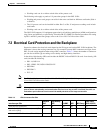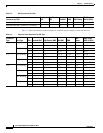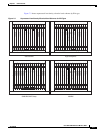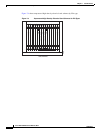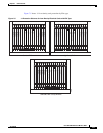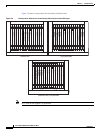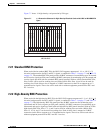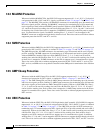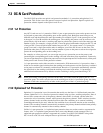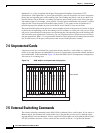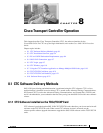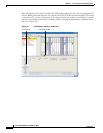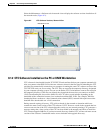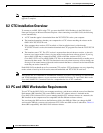
7-13
Cisco ONS 15454 Reference Manual, R8.5.x
78-18106-01
Chapter 7 Card Protection
7.3 OC-N Card Protection
7.3 OC-N Card Protection
The ONS 15454 provides two optical card protection methods, 1+1 protection and optimized 1+1
protection. This section covers the general concept of optical card protection. Specific optical card
protection schemes depend on the optical cards in use.
7.3.1 1+1 Protection
Any OC-N card can use 1+1 protection. With 1+1 port-to-port protection, ports on the protect card can
be assigned to protect the corresponding ports on the working card. Both ports must belong to two
different cards and should have the same port number. For example, if port 2 is the protect port on Card
A then port 2 on Card B would be the working port. The working and protect cards do not have to be
placed side by side in the node. A working card must be paired with a protect card of the same type and
number of ports. For example, a single-port OC-12 must be paired with another single-port OC-12, and
a four-port OC-12 must be paired with another four-port OC-12. You cannot create a 1+1 protection
group if one card is single-port and the other is multiport, even if the OC-N rates are the same. The
protection takes place on the port level, and any number of ports on the protect card can be assigned to
protect the corresponding ports on the working card.
For example, on a four-port card, you can assign one port as a protection port on the protect card
(protecting the corresponding port on the working card) and leave three ports unprotected. Conversely,
you can assign three ports as protection ports and leave one port unprotected. In other words, all the ports
on the protect card are used in the protection scheme.
1+1 span protection can be either revertive or nonrevertive. With nonrevertive 1+1 protection, when a
failure occurs and the signal switches from the working card to the protect card, the signal stays switched
to the protect card until it is manually switched back. Revertive 1+1 protection automatically switches
the signal back to the working card when the working card comes back online. 1+1 protection is
unidirectional and nonrevertive by default; revertive switching is easily provisioned using CTC.
Note When provisioning a line timing reference for the node, you cannot select the protect port of a 1+1
protection group. If a traffic switch occurs on the working port of the 1+1 protection group, the timing
reference of the node automatically switches to the protect port of the 1+1 protection group.
7.3.2 Optimized 1+1 Protection
Optimized 1+1 protection is used in networks that mainly use the linear 1+1 bidirectional protection
scheme. Optimized 1+1 is a line-level protection scheme using two lines, working and protect. One of
the two lines assumes the role of the primary channel, where traffic is selected, and the other line
assumes the role of secondary channel, which protects the primary channel. Traffic switches from the
primary channel to the secondary channel based on either line conditions or an external switching
command performed by the user. After the line condition clears, the traffic remains on the secondary
channel. The secondary channel is automatically renamed as the primary channel and the former primary
channel is automatically renamed as the secondary channel.
Unlike 1+1 span protection, 1+1 optimized span protection does not use the revertive or nonrevertive
feature. Also, 1+1 optimized span protection does not use the Manual switch command. The 1+1
optimized span protection scheme is supported only on the Cisco ONS 15454 SONET using either
OC3-4 cards or OC3-8 cards with ports that are provisioned for SDH payloads.



